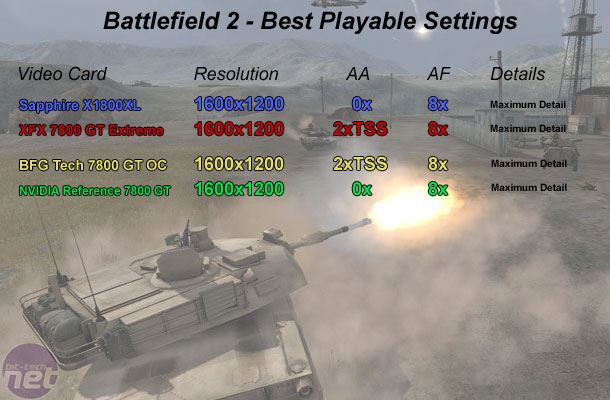Battlefield 2
Publisher: Electronic ArtsBattlefield 2 features an all-new game engine based on the DirectX 9.0 API. There is no Shader Model 3.0 support, but the majority of hardware will use a Shader Model 2.0++ mode that includes support for Normal Maps, Parallax Mapping, Full-Resolution Dynamic Shadowing, Post Processing and Fog.
The game will look the same on both NVIDIA and ATI hardware, so there is no advantage of choosing one over the other in image quality related circumstances. The only major difference is that Ultra Shadow 2 is utilised on NVIDIA's hardware, while the shadowing on ATI hardware is done using a slightly different technique.
We played three five-minute segments of the same map, reporting the median frame rate. We found that there was no ready way to duplicate testing situations manually in this game, so we felt that taking a typical slice of action from the game was the best way to report our findings. We controlled Anti-Aliasing from inside the game, while Anisotropic Filtering was set to 8xAF when the 'Texture Filtering' option was set to 'High'.
Below is a table of the best-playable settings that we found best for each video card configuration. In this title, we found that 25 to 30 frames per second minimum and a target of 60 frames per second (or higher) for the average frame rate delivered a smooth and fluid gaming experience.

We tried both Anti-Aliasing and High Quality AF on the Sapphire X1800XL, but found that both came at too much of a performance hit. The average frame rate on the Sapphire X1800XL was higher than our requirements with 2xAA applied, but we experienced far too much stuttering when we were involved in heavy firefights. Maybe with some newer drivers when memory management has improved a little, we will be able to enable 2xAA on a Radeon X1800XL at 1600x1200.
Both the XFX and BFGTech 7800 GT's performed better than the Sapphire X1800XL in this title, as we were able to apply 2xTSS Anti-Aliasing to the scene with more than acceptable frame rates. In particular, we never saw the frame rate drop below 30 frames per second on the higher clocked XFX 7800 GT.
We feel that the Radeon X1800XL has the potential to outperform a reference-clocked GeForce 7800 GT in this title, but the minimum frame rate really let it down. We believe this is related to memory management, as high memory bandwidth efficiency really helps to improve the minimum frame rates. However, the way that both ATI and NVIDIA are developing drivers, we don't think that the Radeon X1800XL will be able to improve on the two overclocked-out-of-the-box video cards from XFX and BFGTech.

MSI MPG Velox 100R Chassis Review
October 14 2021 | 15:04








Want to comment? Please log in.